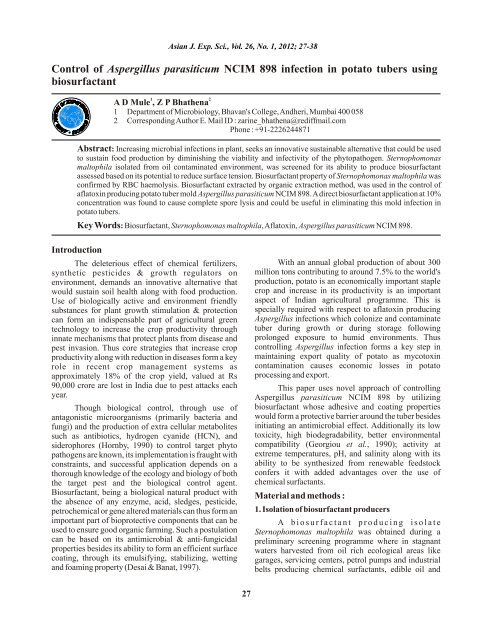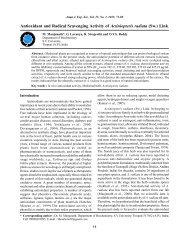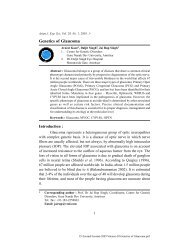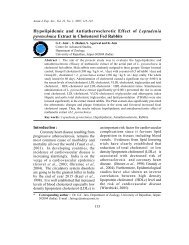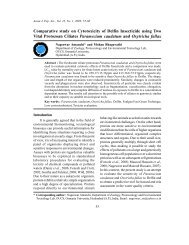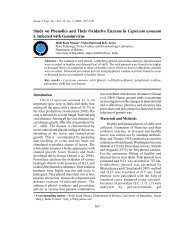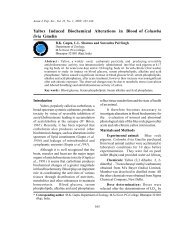Control of Aspergillus parasiticum NCIM 898 infection in ... - Ajes.in
Control of Aspergillus parasiticum NCIM 898 infection in ... - Ajes.in
Control of Aspergillus parasiticum NCIM 898 infection in ... - Ajes.in
Create successful ePaper yourself
Turn your PDF publications into a flip-book with our unique Google optimized e-Paper software.
Asian J. Exp. Sci., Vol. 26, No. 1, 2012; 27-38<br />
<strong>Control</strong> <strong>of</strong> <strong>Aspergillus</strong> <strong>parasiticum</strong> <strong>NCIM</strong> <strong>898</strong> <strong><strong>in</strong>fection</strong> <strong>in</strong> potato tubers us<strong>in</strong>g<br />
biosurfactant<br />
1 2<br />
A D Mule , Z P Bhathena<br />
1 Department <strong>of</strong> Microbiology, Bhavan's College, Andheri, Mumbai 400 058<br />
2 Correspond<strong>in</strong>g Author E. Mail ID : zar<strong>in</strong>e_bhathena@rediffmail.com<br />
Phone : +91-2226244871<br />
Abstract: Increas<strong>in</strong>g microbial <strong><strong>in</strong>fection</strong>s <strong>in</strong> plant, seeks an <strong>in</strong>novative susta<strong>in</strong>able alternative that could be used<br />
to susta<strong>in</strong> food production by dim<strong>in</strong>ish<strong>in</strong>g the viability and <strong>in</strong>fectivity <strong>of</strong> the phytopathogen. Sternophomonas<br />
maltophila isolated from oil contam<strong>in</strong>ated environment, was screened for its ability to produce biosurfactant<br />
assessed based on its potential to reduce surface tension. Biosurfactant property <strong>of</strong> Sternophomonas maltophila was<br />
confirmed by RBC haemolysis. Biosurfactant extracted by organic extraction method, was used <strong>in</strong> the control <strong>of</strong><br />
aflatox<strong>in</strong> produc<strong>in</strong>g potato tuber mold <strong>Aspergillus</strong> <strong>parasiticum</strong> <strong>NCIM</strong> <strong>898</strong>. A direct biosurfactant application at 10%<br />
concentration was found to cause complete spore lysis and could be useful <strong>in</strong> elim<strong>in</strong>at<strong>in</strong>g this mold <strong><strong>in</strong>fection</strong> <strong>in</strong><br />
potato tubers.<br />
Introduction<br />
Key Words: Biosurfactant, Sternophomonas maltophila, Aflatox<strong>in</strong>, <strong>Aspergillus</strong> <strong>parasiticum</strong> <strong>NCIM</strong> <strong>898</strong>.<br />
The deleterious effect <strong>of</strong> chemical fertilizers,<br />
synthetic pesticides & growth regulators on<br />
environment, demands an <strong>in</strong>novative alternative that<br />
would susta<strong>in</strong> soil health along with food production.<br />
Use <strong>of</strong> biologically active and environment friendly<br />
substances for plant growth stimulation & protection<br />
can form an <strong>in</strong>dispensable part <strong>of</strong> agricultural green<br />
technology to <strong>in</strong>crease the crop productivity through<br />
<strong>in</strong>nate mechanisms that protect plants from disease and<br />
pest <strong>in</strong>vasion. Thus core strategies that <strong>in</strong>crease crop<br />
productivity along with reduction <strong>in</strong> diseases form a key<br />
role <strong>in</strong> recent crop management systems as<br />
approximately 18% <strong>of</strong> the crop yield, valued at Rs<br />
90,000 crore are lost <strong>in</strong> India due to pest attacks each<br />
year.<br />
Though biological control, through use <strong>of</strong><br />
antagonistic microorganisms (primarily bacteria and<br />
fungi) and the production <strong>of</strong> extra cellular metabolites<br />
such as antibiotics, hydrogen cyanide (HCN), and<br />
siderophores (Hornby, 1990) to control target phyto<br />
pathogens are known, its implementation is fraught with<br />
constra<strong>in</strong>ts, and successful application depends on a<br />
thorough knowledge <strong>of</strong> the ecology and biology <strong>of</strong> both<br />
the target pest and the biological control agent.<br />
Biosurfactant, be<strong>in</strong>g a biological natural product with<br />
the absence <strong>of</strong> any enzyme, acid, sledges, pesticide,<br />
petrochemical or gene altered materials can thus form an<br />
important part <strong>of</strong> bioprotective components that can be<br />
used to ensure good organic farm<strong>in</strong>g. Such a postulation<br />
can be based on its antimicrobial & anti-fungicidal<br />
properties besides its ability to form an efficient surface<br />
coat<strong>in</strong>g, through its emulsify<strong>in</strong>g, stabiliz<strong>in</strong>g, wett<strong>in</strong>g<br />
and foam<strong>in</strong>g property (Desai & Banat, 1997).<br />
27<br />
With an annual global production <strong>of</strong> about 300<br />
million tons contribut<strong>in</strong>g to around 7.5% to the world's<br />
production, potato is an economically important staple<br />
crop and <strong>in</strong>crease <strong>in</strong> its productivity is an important<br />
aspect <strong>of</strong> Indian agricultural programme. This is<br />
specially required with respect to aflatox<strong>in</strong> produc<strong>in</strong>g<br />
<strong>Aspergillus</strong> <strong><strong>in</strong>fection</strong>s which colonize and contam<strong>in</strong>ate<br />
tuber dur<strong>in</strong>g growth or dur<strong>in</strong>g storage follow<strong>in</strong>g<br />
prolonged exposure to humid environments. Thus<br />
controll<strong>in</strong>g <strong>Aspergillus</strong> <strong><strong>in</strong>fection</strong> forms a key step <strong>in</strong><br />
ma<strong>in</strong>ta<strong>in</strong><strong>in</strong>g export quality <strong>of</strong> potato as mycotox<strong>in</strong><br />
contam<strong>in</strong>ation causes economic losses <strong>in</strong> potato<br />
process<strong>in</strong>g and export.<br />
This paper uses novel approach <strong>of</strong> controll<strong>in</strong>g<br />
<strong>Aspergillus</strong> <strong>parasiticum</strong> <strong>NCIM</strong> <strong>898</strong> by utiliz<strong>in</strong>g<br />
biosurfactant whose adhesive and coat<strong>in</strong>g properties<br />
would form a protective barrier around the tuber besides<br />
<strong>in</strong>itiat<strong>in</strong>g an antimicrobial effect. Additionally its low<br />
toxicity, high biodegradability, better environmental<br />
compatibility (Georgiou et al., 1990); activity at<br />
extreme temperatures, pH, and sal<strong>in</strong>ity along with its<br />
ability to be synthesized from renewable feedstock<br />
confers it with added advantages over the use <strong>of</strong><br />
chemical surfactants.<br />
Material and methods :<br />
1. Isolation <strong>of</strong> biosurfactant producers<br />
A b i o s u r f a c t a n t p r o d u c i n g i s o l a t e<br />
Sternophomonas maltophila was obta<strong>in</strong>ed dur<strong>in</strong>g a<br />
prelim<strong>in</strong>ary screen<strong>in</strong>g programme where <strong>in</strong> stagnant<br />
waters harvested from oil rich ecological areas like<br />
garages, servic<strong>in</strong>g centers, petrol pumps and <strong>in</strong>dustrial<br />
belts produc<strong>in</strong>g chemical surfactants, edible oil and
petroleum products were assessed.<br />
The isolates were obta<strong>in</strong>ed primarily on<br />
Christova M<strong>in</strong>eral medium conta<strong>in</strong><strong>in</strong>g 2% paraff<strong>in</strong> oil<br />
after <strong>in</strong>cubation for 48 hours and selected as<br />
biosurfactant producers based on the rational that<br />
paraff<strong>in</strong> utilization <strong>in</strong>volves the production <strong>of</strong><br />
biosurfactant. (Desai and Banat,1997). Assessment <strong>of</strong><br />
biosurfactant produc<strong>in</strong>g isolate was also carried out<br />
us<strong>in</strong>g<br />
A. Quantitative Haemolysis assay: (Dehghan-Noudeh<br />
et al., 2005) In 5% human RBC suspension prepared <strong>in</strong><br />
McIlva<strong>in</strong>e's buffer (0.2 ml) was <strong>in</strong>cubated for 30 m<strong>in</strong> at<br />
37°C with an equal volume <strong>of</strong> metabolic filtrate<br />
obta<strong>in</strong>ed by grow<strong>in</strong>g S. maltophila <strong>in</strong> Christova's<br />
m<strong>in</strong>eral medium supplemented with 2% paraff<strong>in</strong> oil for<br />
o<br />
96 hours, at 25 C. After <strong>in</strong>cubation, the mixtures were<br />
spun <strong>in</strong> a micro centrifuge (Eltech) at 3000 rpm for 30s.<br />
0.2 ml <strong>of</strong> the result<strong>in</strong>g supernatant was then added to 3<br />
ml Drabk<strong>in</strong>'s reagent (LOBA chemicals) to assess the<br />
amount <strong>of</strong> haemoglob<strong>in</strong> released. Appropriate positive<br />
and negative controls were set up. The absorbance <strong>of</strong> the<br />
samples was determ<strong>in</strong>ed calorimetrically at 540 nm and<br />
% heamolysis calculated as:-<br />
Percentage haemolysis = OD --- OD × 100<br />
(test) (0% control)<br />
OD(100% control )<br />
b. Surface tension reduction activity (Desai and<br />
Banat, 1997, S<strong>in</strong>gh and Desai, 1989)<br />
Surface activity was measured us<strong>in</strong>g CDS-<br />
DuNouy r<strong>in</strong>g tensiometer. 24 hr old S. maltophila<br />
suspension at OD <strong>of</strong> 0.5 was used to <strong>in</strong>oculate<br />
540nm<br />
Christova m<strong>in</strong>eral broth. The flask was <strong>in</strong>cubated under<br />
shake conditions for 92 h and the metabolic filtrate<br />
harvested by centrifugation. Surface tension was<br />
measured by plac<strong>in</strong>g the plat<strong>in</strong>um-iridium r<strong>in</strong>g just<br />
below the surface <strong>of</strong> metabolic filtrate solution, which<br />
then rose through the surface <strong>of</strong> the aqueous solution<br />
until the r<strong>in</strong>g broke. The amount <strong>of</strong> force required for<br />
break<strong>in</strong>g through the surface layer was recorded <strong>in</strong><br />
3<br />
dynes/cm , us<strong>in</strong>g Kruss K 10 tensiometer.<br />
c. Emulsification <strong>in</strong>dex (EI): (Morikawa et al., 1993)<br />
4 ml <strong>of</strong> 72 h metabolic filtrate obta<strong>in</strong>ed after<br />
growth <strong>of</strong> S. maltophila on Christova m<strong>in</strong>eral medium<br />
conta<strong>in</strong><strong>in</strong>g 2% paraff<strong>in</strong> as a carbon source was overlaid<br />
& mixed with 4 ml <strong>of</strong> oil substrates (paraff<strong>in</strong> oil) <strong>in</strong> a<br />
dilution glass test tube (16 by 150 mm).The height <strong>of</strong> the<br />
oil layer <strong>in</strong> the tube was measured <strong>in</strong> cm. The tubes were<br />
then vortex for 3 m<strong>in</strong> and then shaken manually for 2<br />
m<strong>in</strong> to create an emulsion. The height <strong>of</strong> the emulsion<br />
layer was measured after 2 h & 24 hr and emulsification<br />
<strong>in</strong>dex (EI) calculated us<strong>in</strong>g the follow<strong>in</strong>g formula:-<br />
Asian J. Exp. Sci., Vol. 26, No. 1, 2012; 27-38<br />
28<br />
EI (%) = (height <strong>of</strong> emulsion layer)/ (height <strong>of</strong> the oil<br />
plus emulsion layer) X 100.<br />
2 Biosurfactant Production, Extraction and<br />
Purification : (Rahman and Gakpe, 2008)<br />
Potent bacterial isolates S. maltophila was<br />
2<br />
adjusted to a f<strong>in</strong>al density <strong>of</strong> 1X 10 cfu/ml <strong>in</strong> 50 ml <strong>of</strong><br />
Christova's M<strong>in</strong>eral medium with 2% paraff<strong>in</strong>. The<br />
o<br />
flask was <strong>in</strong>cubated at 30 C for 96 h under shaker<br />
condition <strong>of</strong> 100 rpm.<br />
Metabolic filtrate harvested after centrifugation<br />
was adjusted to pH 2 us<strong>in</strong>g 6 N HCl. After an overnight<br />
0<br />
<strong>in</strong>cubation at 4 C equal volumes <strong>of</strong> chilled mixture <strong>of</strong><br />
chlor<strong>of</strong>orm and methanol (2:1) was added to obta<strong>in</strong> the<br />
biosurfactant conta<strong>in</strong><strong>in</strong>g organic layer, which was dried<br />
0<br />
at 40 C for 3 hours. The extraction process was repeated<br />
thrice and the dried mass obta<strong>in</strong>ed weighed and its<br />
prote<strong>in</strong> content was determ<strong>in</strong>ed by Lowry et al. (1951)<br />
method. The extracted biosurfactant was then subjected<br />
to adsorption chromatography (Sa<strong>in</strong>i et al., 2005) us<strong>in</strong>g<br />
silica gel solid-phase column (mesh size 200-300 mesh,<br />
1cm diameter, 6 cm length) saturated with solvents <strong>of</strong><br />
gradually <strong>in</strong>creas<strong>in</strong>g polarity <strong>in</strong> the order <strong>of</strong> chlor<strong>of</strong>orm,<br />
acetone, chlor<strong>of</strong>orm: methyl alcohol (2:1), and methyl<br />
alcohol: Water (2:1). The surfactant harvested was<br />
eluted by sterile glass distilled water overnight to<br />
remove the rema<strong>in</strong><strong>in</strong>g cations, while smaller fractions <strong>of</strong><br />
prote<strong>in</strong>s were removed by add<strong>in</strong>g chilled iso-butanol<br />
(10%) and by centrifugation at 4000 rpm for 10 m<strong>in</strong>.<br />
o<br />
Supernatant was then stored after lyophilization at 4 C<br />
and used as stock surfactant.<br />
3. Sporolytic activity<br />
Zoospores <strong>of</strong> <strong>Aspergillus</strong> parasiticus <strong>NCIM</strong> <strong>898</strong><br />
were harvested us<strong>in</strong>g the method described by Zhou and<br />
Paulitz (1993), where <strong>in</strong> the fungi grown for 72 hours on<br />
Sabourauds agar supplemented with 1% CaCO was<br />
3<br />
flooded with 20 ml <strong>of</strong> sterile distilled water<br />
supplemented with 0.1% Tween 80. After 2 h the<br />
zoospore were harvested by centrifugation and stored <strong>in</strong><br />
o<br />
sal<strong>in</strong>e at 4 C.<br />
1 ml <strong>of</strong> purified biosurfactant <strong>of</strong> S.maltophilia<br />
prepared <strong>in</strong> concentration <strong>of</strong> 2%, 4%, 6%, 8%, and 10%<br />
was mixed with 1 ml <strong>of</strong> <strong>Aspergillus</strong> parasiticus <strong>NCIM</strong><br />
<strong>898</strong> spore suspensions adjusted to m<strong>in</strong>imum <strong>in</strong>fectivity<br />
3<br />
<strong>in</strong>dex <strong>of</strong> 1 X10 spores/ ml (Kasprzyk, 2002) and<br />
<strong>in</strong>cubated for time <strong>in</strong>tervals <strong>of</strong> 10, 40, 60, 80, 100 & 120<br />
m<strong>in</strong>s respectively. The spore biosurfactant mixture was<br />
then observed for the <strong>in</strong>tegrity / burst<strong>in</strong>g <strong>of</strong> the spore<br />
under phase contrast microscope (Olympus CX 31<br />
Asbestos Phase Contrast Microscope). Viability <strong>of</strong><br />
spores was further confirmed by plat<strong>in</strong>g the spore<br />
biosurfactant mixture on Sabouraud's Agar. Percentage<br />
decl<strong>in</strong>e <strong>in</strong> spore viability due to the treatment <strong>of</strong>
iosurfactant was assessed us<strong>in</strong>g appropriate controls.<br />
4. Sporolytic activity <strong>of</strong> biosurfactant to control<br />
potato tuber wilt <strong>in</strong>festation<br />
Mid size potato tubers collected from Borivali<br />
market, were washed twice with sterile distilled water,<br />
followed by immers<strong>in</strong>g <strong>in</strong> 2% sodium hypochlorite<br />
solution for 10 m<strong>in</strong> to ensure surface sterilization.<br />
Excess sodium hypochlorite was removed by repeated<br />
wash<strong>in</strong>g with sterile distilled water. The tubers were<br />
then randomly divided <strong>in</strong>to two groups, such that each<br />
labeled test and control group conta<strong>in</strong>ed at least ten<br />
uniformly sized tubers. The test tubers were then<br />
3<br />
sprayed with 3 ml <strong>of</strong> 1 X10 spores/ ml, suspension <strong>of</strong><br />
<strong>Aspergillus</strong> parasiticus <strong>NCIM</strong> <strong>898</strong> us<strong>in</strong>g spray pump.<br />
After an <strong>in</strong>terval <strong>of</strong> 5 m<strong>in</strong> the tubers were then sprayed<br />
with 10 ml <strong>of</strong> 10% biosurfactant suspension. In contrast,<br />
the control group was sprayed only with <strong>Aspergillus</strong><br />
parasiticus <strong>NCIM</strong> <strong>898</strong> spore suspension. Additionally, a<br />
negative control group conta<strong>in</strong><strong>in</strong>g only surface<br />
sterilized potato tuber without any spray treatments was<br />
also <strong>in</strong>cluded<br />
After 1 hr the excess liquid with<strong>in</strong> each group if<br />
any was decanted and the potato tubers were <strong>in</strong>cubated<br />
o<br />
at 25 C for 1 week <strong>in</strong>terval and graded for <strong>in</strong>fectivity<br />
accord<strong>in</strong>g to Percent Disease Index (PDI) (Rahman et<br />
al., 2008) (Table 1). Additionally, percentage decl<strong>in</strong>e <strong>in</strong><br />
<strong>in</strong>fectivity due to the treatment <strong>of</strong> biosurfactant was<br />
assessed through determ<strong>in</strong>ation <strong>of</strong> total <strong>Aspergillus</strong><br />
2<br />
count /cm on Sabouraud's Agar.<br />
Result and Discussion<br />
The prevalence <strong>of</strong> potent biosurfactant<br />
produc<strong>in</strong>g microorganisms from oil contam<strong>in</strong>ated sites<br />
Asian J. Exp. Sci., Vol. 26, No. 1, 2012; 27-38<br />
29<br />
were studied from selected ecosystems based on the<br />
rationale that a high oil concentration <strong>in</strong>creases the<br />
predom<strong>in</strong>ance <strong>of</strong> surface active agent produc<strong>in</strong>g<br />
organisms. Liquid paraff<strong>in</strong> which is a common agent<br />
used <strong>in</strong> fuels, pa<strong>in</strong>ts, pigments, dyes and <strong>in</strong>ks, wax,<br />
medic<strong>in</strong>e (laxative), cul<strong>in</strong>ary, toiletries and cosmetics<br />
was used as source <strong>of</strong> hydrocarbon for primary<br />
screen<strong>in</strong>g as biosurfactants are associated with the<br />
uptake <strong>of</strong> hydrophobic carbon substrates like paraff<strong>in</strong><br />
(Lang and Wullbrandt, 1999). Additionally paraff<strong>in</strong><br />
utilization <strong>in</strong>volves break<strong>in</strong>g <strong>of</strong> carbon cha<strong>in</strong> C14-C 18,<br />
which occurs at the <strong>in</strong>terphase <strong>of</strong> water and <strong>in</strong>soluble<br />
hydrocarbon, (Cresenzi, 1995) and its dispersion is<br />
enhanced through production <strong>of</strong> biosurfactant.<br />
(Rosenberg, 1988). Thus us<strong>in</strong>g paraff<strong>in</strong> as the sole<br />
source <strong>of</strong> carbon <strong>in</strong> m<strong>in</strong>eral Christova's medium enabled<br />
recovery <strong>of</strong> biosurfactant produc<strong>in</strong>g isolates.<br />
Though most <strong>of</strong> the sampl<strong>in</strong>g sites showed high<br />
4 8<br />
heterotrophic load rang<strong>in</strong>g between 10 to 10 cfu/g,<br />
(Table 2) maximum localization <strong>of</strong> biosurfactant<br />
producers were obta<strong>in</strong>ed from soil samples collected<br />
from an Edible Oil Industry. This is similar to the results<br />
<strong>of</strong> Balogun and Fagade (2008) who reported a high<br />
heterotrophic load which reduced at least by two to three<br />
log when assessed for population that were<br />
biosurfactant producers. Tabatabae et al., (2005) also<br />
reported total heterotrophic cell counts <strong>of</strong> oil well with<strong>in</strong><br />
3 5 2<br />
the range <strong>of</strong> 10 -10 cfu <strong>of</strong> which only 10 cfu were found<br />
to be potent biosurfactant producers.<br />
Thus though four different samples were<br />
assessed and 19 different isolates were obta<strong>in</strong>ed , petrol<br />
pump sample showed maximum isolates. This could be<br />
related to the prevalence <strong>of</strong> hydrocarbon and oil <strong>in</strong> the<br />
Table 1: Percent Disease Index (PDI) <strong>of</strong> potato tuber <strong><strong>in</strong>fection</strong> ( Rahman et al ., 2008)<br />
Sr. No. Areas affected per tubers Infectivity<br />
1. None or very few lesions on the tubers. 0<br />
2. More than 1% but less than 10% lesions on the tubers. 3<br />
3. More than 10% but less than 25% lesions on the tubers. 10<br />
4. More than 25% but less than 50% lesions on the tubers. 25<br />
5. Half <strong>of</strong> the foliage destroyed 50<br />
6. More than 50% but less than 75%. <strong>of</strong> the foliage destroyed 75<br />
7. More than 75% but less than 90% <strong>of</strong> the foliage destroyed 90<br />
Index<br />
9. Tuber completely destroyed 100
ecosystem. A bacterial community <strong>in</strong> contam<strong>in</strong>ated site<br />
tends to be dom<strong>in</strong>ated by the stra<strong>in</strong>s that survive the<br />
zenobiotic entity or is able to utilize it for its growth. In<br />
response to paraff<strong>in</strong> oil <strong>in</strong> the Christova's medium the<br />
organisms which are already acclimatized to the<br />
hydrocarbons <strong>in</strong> spilled eng<strong>in</strong>e oil, grease, petrol, and<br />
diesel could utilize paraff<strong>in</strong> as a sole source <strong>of</strong> carbon<br />
and hence could be obta<strong>in</strong>ed <strong>in</strong> higher numbers as<br />
compared to those obta<strong>in</strong>ed from other sampl<strong>in</strong>g sites.<br />
Bernheimer and Avigad (1970) reported that the<br />
biosurfactant produced by Bacillus could lyse blood and<br />
s<strong>in</strong>ce then has been used to quantify surfact<strong>in</strong>s (Moran et<br />
al., 2002) and rhamnolipids . Johnson and Boese-<br />
Marrazzo, 1980 and Carrillo et al. (1996) found an<br />
association between haemolytic activity and surfactant<br />
production, and recommended the use <strong>of</strong> blood agar for<br />
observ<strong>in</strong>g lysis as a primary method to screen for<br />
biosurfactant activity. Aga<strong>in</strong>st the Cx ratio <strong>of</strong> 1.6 and<br />
1.55 and % heamolysis <strong>of</strong> 22% and 24% obta<strong>in</strong>ed with<br />
standard stra<strong>in</strong>s Bacillus subtilis MTCC 2423,<br />
Pseudomonas aerug<strong>in</strong>osa MTCC 2297 respectively,<br />
our isolate show<strong>in</strong>g greater % heamolysis values (Table<br />
3).<br />
Denger and Sch<strong>in</strong>k (1995) reported a direct<br />
correlation between surface activity and emulsification<br />
activity such that emulsification <strong>in</strong>dex has been used as<br />
a efficient screen<strong>in</strong>g method to detect surface active<br />
molecules (Denger and Sch<strong>in</strong>k, 1995; Makkar and<br />
Cameotra, 1998). Emulsions be<strong>in</strong>g unstable do not form<br />
spontaneously, and energy <strong>in</strong>put through shak<strong>in</strong>g,<br />
stirr<strong>in</strong>g, homogeniz<strong>in</strong>g, or spray processes are<br />
frequently needed. Surface active substances (biosurfactants)<br />
can <strong>in</strong>crease the k<strong>in</strong>etic stability <strong>of</strong><br />
Asian J. Exp. Sci., Vol. 26, No. 1, 2012; 27-38<br />
Table 2: Primary screen<strong>in</strong>g <strong>of</strong> isolates from various sampl<strong>in</strong>g sites based on paraff<strong>in</strong> utilization<br />
Sr. Number Soil samples collected from Total<br />
heterotrophic<br />
load cfu/gm<br />
A. Soil Near Garage<br />
30<br />
Total<br />
paraff<strong>in</strong><br />
utilizers<br />
cfu/gm<br />
Number <strong>of</strong><br />
OTU<br />
Sai Car Servic<strong>in</strong>g Center &<br />
Garage<br />
2.63X10 8 2.11X10 4 8<br />
B. Soil Sample Near Oil<br />
Conta<strong>in</strong><strong>in</strong>g Ecosystem<br />
Edible Oil Industry 2.98X10 5 8.14X10 4 11<br />
C. Soil Near Petrol Pump<br />
Borivali Petrol Pump 3.64X10 4 5.64X10 2 14<br />
D. Environmental sample<br />
Stagnant puddle water 5.71X10 4 2.11X10 4 6<br />
emulsions so that, once formed, the emulsion does not<br />
revert back <strong>in</strong>to their separate phases over a<br />
considerable period <strong>of</strong> storage, as the polar groups<br />
with<strong>in</strong> the molecule orient toward water, while its nonpolar<br />
fraction are oriented toward the oil. Thus<br />
surfactant molecule lowers the <strong>in</strong>terfacial tension<br />
between the oil and water phases. Surface tension at the<br />
air/water and oil/water <strong>in</strong>terfaces can be most accurately<br />
measured us<strong>in</strong>g a tensiometer where <strong>in</strong> addition <strong>of</strong> the<br />
metabolite <strong>in</strong> air/water or oil/water systems at<br />
<strong>in</strong>creas<strong>in</strong>g concentrations, can cause a reduction <strong>of</strong><br />
surface tension up to a critical level, above which<br />
amphiphilic molecules associate readily to form<br />
supramolecular structures like micelles, bilayers, and<br />
vesicle. Lang & Wullbrandt (1999) reported that the<br />
3<br />
surface tension <strong>of</strong> distilled water is 72 dynes/cm , and<br />
addition <strong>of</strong> surfactant like molecules can lower this<br />
3<br />
value to 30 dynes/cm & beyond. Thus, our bacterial<br />
isolate Sternophomonas maltophila which showed<br />
higher haemolysis (88%) , potent surface tension<br />
reduction (72.36% ), and higher emulsification activity<br />
(S<strong>in</strong>gh and Desai, 1989) was used for further studies.<br />
2.Biosurfactant Production, extraction and<br />
purification<br />
At low pH value biosurfactants become <strong>in</strong>soluble<br />
which can be then precipitated and re-dissolved <strong>in</strong><br />
organic solvents ow<strong>in</strong>g to the hydrophobic ends <strong>in</strong> the<br />
molecule (Swam<strong>in</strong>athan, 2011). Based on its molecular<br />
weight, chemical nature, form and solubility<br />
biosurfactants have been extracted by use <strong>of</strong> various<br />
organic solvents like methanol & chlor<strong>of</strong>orm (Bryant,<br />
1990), hexane (Morikawa et al., 1993 and Barkay et al.,
Number <strong>of</strong> Isolates<br />
A. Soil Near Garage<br />
1999), dichloromethane (Cooper et al., 1981), pentane<br />
(Macdonald et al., 1981) have been used to extract.<br />
Hence selection <strong>of</strong> organic solvent needs to be<br />
standardized as suitable solvent plays important role <strong>in</strong><br />
efficiency <strong>of</strong> the downstream recovery process the<br />
results <strong>of</strong> which are shown <strong>in</strong> Fig. 1. Chilled mixture <strong>of</strong><br />
Chlor<strong>of</strong>orm: Methanol (2:1) caused maximum<br />
extraction <strong>of</strong> biosurfactant <strong>in</strong> organic layer for all the<br />
four different isolates studied though yields from isolate<br />
Asian J. Exp. Sci., Vol. 26, No. 1, 2012; 27-38<br />
Table 3: Screen<strong>in</strong>g <strong>of</strong> Garage soil sample for Biosurfactant activity<br />
Cx<br />
Ratio<br />
31<br />
%Haemolysis EI(24 h) % Surface<br />
Tension<br />
Reduction<br />
SS 1 1.21 2 3 3<br />
SS 2 1.36 1 4 2<br />
SS 3 1.78 14 8 7<br />
B. Soil Sample Near Oil Conta<strong>in</strong><strong>in</strong>g Ecosystem<br />
K 1 0.9 1.24 14 10<br />
K 2 1.55 1.35 5 2<br />
K 3 1.36 1.32 4 1<br />
K 4 1.98 52 6 16.66<br />
K 5 1.54 1.54 3 4.1<br />
K 6 A 1.96 88 28 72.36<br />
C. Soil Near Petrol Pump<br />
S 1 1.23 5 5 9<br />
S 2 1.65 10 7 6<br />
S 3 1.85 12 6 2<br />
S 4 1.69 18 2 4<br />
S 5 1.27 4 5 7<br />
S 6 1.95 22 2 6<br />
S7 1.36 1.32 4 4<br />
S9 1.85 12 6 2<br />
D. Environnemental sample<br />
GP 1 0 0<br />
GP 2 1.65 54 20 68.88<br />
GP 3 1.85 26 3 10.21<br />
E. coli (-ve <strong>Control</strong>) 0 2 0 2<br />
Bacillus subtilis. MTCC 2423<br />
Pseudomonas aerug<strong>in</strong>osa<br />
MTCC 2297<br />
1.5<br />
1.55<br />
22<br />
24<br />
Stenotrophomonas maltophilia were approximately 2<br />
folds more than that obta<strong>in</strong>ed from standard<br />
biosurfactant producer Bacillus subtilis MTCC 2423 &<br />
Pseudomonas aerug<strong>in</strong>osa MTCC 2297.<br />
Methanol and chlor<strong>of</strong>orm <strong>in</strong> various ratios have<br />
been rout<strong>in</strong>ely used to extract lipids and thus forms an<br />
ideal extraction solvent system. In spite <strong>of</strong> that variation<br />
<strong>in</strong> the extraction efficacy was detected. Cooper et al.<br />
(1981) used Chlor<strong>of</strong>orm-methanol-water mixture<br />
12<br />
16<br />
60<br />
55
Key<br />
g%<br />
3<br />
2.5<br />
2<br />
1.5<br />
1<br />
0.5<br />
Method<br />
Number<br />
0<br />
Asian J. Exp. Sci., Vol. 26, No. 1, 2012; 27-38<br />
Figure 1. Biosurfactant extraction us<strong>in</strong>g organic extraction process<br />
K 6 2 A<br />
K 6 2 B<br />
Bacillus subtilis. MTCC 2423<br />
Pseudomonas aerug<strong>in</strong>osa MTCC 2297<br />
1 2 3 4 5 6<br />
Method Number<br />
Reference Organic Solvents Used<br />
1. Cooper et al 1979 Chlor<strong>of</strong>orm- methanol- water (2:1:1)<br />
2. Bryant 1990 Ethyl acetate methanol Silicic acid<br />
(1:2:1)<br />
3. Morikawa 1993 & Barkay et<br />
al 1999<br />
Hexane CH3 (CH2)4CH3<br />
4. Cooper et al 1981 Dichloromethane (CH2Cl2)<br />
5. Macdonald et al 1981 Pentane (C5H12)<br />
6.<br />
Desai & Banat 1997 Chlor<strong>of</strong>orm: Methanol(2:1)<br />
[CHCl -CH OH-H O] to extract surfactant from<br />
3 3 2<br />
Corynebacterium lepus, however, very little<br />
biosurfactant was isolated by this method <strong>in</strong> our study<br />
This could be attributed to the use <strong>of</strong> water <strong>in</strong> which<br />
chlor<strong>of</strong>orm largely rema<strong>in</strong>s immisicible and the actual<br />
ratio <strong>of</strong> Chlor<strong>of</strong>orm-methanol-water used <strong>in</strong> the<br />
experiment. It is reported that the system <strong>of</strong> lipid<br />
extraction could be best designed by ma<strong>in</strong>ta<strong>in</strong><strong>in</strong>g the<br />
chlor<strong>of</strong>orm, methanol and water <strong>in</strong> the comb<strong>in</strong>ed phases<br />
to 8:4:3 (by volume), otherwise selective losses <strong>of</strong> lipid<br />
may occur. In our experimental setup chlor<strong>of</strong>orm,<br />
methanol and water was ma<strong>in</strong>ta<strong>in</strong>ed <strong>in</strong> 10:5:7 (by<br />
volume) as described by Cooper and Goldenberg (1981)<br />
and could be one <strong>of</strong> the reasons <strong>of</strong> not yield<strong>in</strong>g<br />
surfactant for the isolate under study.<br />
Purification<br />
Though the metabolic filtrate used for the harvest<br />
32<br />
<strong>of</strong> biosurfactant was free from the bacterial cells,<br />
presence <strong>of</strong> some cellular debris and prote<strong>in</strong>s <strong>of</strong> the<br />
nutrient broth can form major impurities as they<br />
precipitate with chlor<strong>of</strong>orm -methanol along with the<br />
biosurfactant. Hence purification <strong>of</strong> the biosurfactant<br />
was undertaken with respect to the removal <strong>of</strong> prote<strong>in</strong><br />
from the biosurfactants extracted by organic solvent<br />
method by the potent isolate. Biosurfactant on reprecipitat<strong>in</strong>g<br />
yielded 37.5% prote<strong>in</strong> reduction while,<br />
purification <strong>of</strong> biosurfactant through adsorption<br />
chromatography yielded 87.5% prote<strong>in</strong> reduction<br />
without much loss <strong>of</strong> its lipid content<br />
3. Sporolytic activity <strong>of</strong> S. maltophilia biosurfactant<br />
by Phase contrast microscopy<br />
Fungal spore germ<strong>in</strong>ation marks the resumption<br />
<strong>of</strong> vegetative development lead<strong>in</strong>g to the formation <strong>of</strong> a<br />
new <strong>in</strong>dividual or colony. Germ<strong>in</strong>ation, usually follows
a period <strong>of</strong> dormancy, and is said to have occurred with<br />
the development <strong>of</strong> a new hypha. Thus, controll<strong>in</strong>g<br />
fungal <strong><strong>in</strong>fection</strong> at spore germ<strong>in</strong>ation level is<br />
economically crucial step, as it not only saves crop but<br />
also prevent the possible spread <strong>of</strong> the pathogen.<br />
Though fungal spores are microscopic<br />
propagates that lack embryo specialized for dispersal or<br />
dormant survival, spores produced by sexual process<br />
(zoospore & ascospores) are usually functional <strong>in</strong><br />
dormant survival. Such spore populations are<br />
challeng<strong>in</strong>g as their control is not possible by<br />
convenient techniques (Kasprzyk et al., 2002) and<br />
hence seek special attention. The spore cell wall is<br />
thicker than somatic cell, have relatively lower water<br />
content and respiration rate with high content <strong>of</strong> energy<br />
storage material such as lipid glycogen and trehalose<br />
(Kasprzyk et al., 2002) which makes its survival easier<br />
and elim<strong>in</strong>ation crucial. Thus means that effectively<br />
control <strong>of</strong> their germ<strong>in</strong>ation on crop play a crucial role <strong>in</strong><br />
management <strong>of</strong> various plant pathogens.<br />
Qualitative assessment <strong>of</strong> lysis <strong>of</strong> the zoospores<br />
<strong>of</strong> <strong>Aspergillus</strong> parasiticus detected through<br />
heamocytometer (Table 4 & Fig. 2) us<strong>in</strong>g a phase<br />
contrast microscopy at 2% concentration <strong>of</strong><br />
biosurfactant was not effective as it did not cause any<br />
spore lysis even over a time period <strong>of</strong> 120 m<strong>in</strong>s. The<br />
time kill response <strong>of</strong> the biosurfactant at 4%<br />
concentration was also at 120 m<strong>in</strong> as the 94 % reduction<br />
<strong>in</strong> the viability <strong>of</strong> the spore was detected while at 6% &<br />
8% concentration the biosurfactant was sporolytic at<br />
Sr.<br />
No.<br />
Asian J. Exp. Sci., Vol. 26, No. 1, 2012; 27-38<br />
33<br />
lower time period <strong>of</strong> 80 m<strong>in</strong>s (92% effective reduction)<br />
& 60 m<strong>in</strong> (89% effective reduction) respectively. 10%<br />
biosurfactant was the most successful amongst the lot as<br />
it could lyse 100% <strong>of</strong> the spore <strong>in</strong> shortest time <strong>of</strong> 10 m<strong>in</strong><br />
and thus can be the most effective concentration to be<br />
used <strong>in</strong> crop care formulations. Though very little<br />
<strong>in</strong>formation with respect to the proposed mechanism for<br />
zoospore lysis upon exposure to the biosurfactant is<br />
known, motility <strong>of</strong> zoospore was found to be affected<br />
followed by an explosion <strong>of</strong> zoospore. It is reported that<br />
membranes <strong>of</strong> Blastocladiella emersonii zoospores<br />
conta<strong>in</strong>s 49% lipid with most <strong>of</strong> them be<strong>in</strong>g glycolipids<br />
and neutral lipids, and the <strong>in</strong>terplay <strong>of</strong> the surfactant<br />
with such molecules could be the means <strong>of</strong> its effective<br />
lysis.<br />
4. Sporolytic activity <strong>of</strong> biosurfactant <strong>of</strong> S.<br />
maltophilia to control potato tuber wilt <strong>in</strong>festation<br />
Potato (Solanum tuberosum L.) is one <strong>of</strong> the four<br />
major food crops <strong>of</strong> the world as it produces more drybio<br />
mass, has well balanced prote<strong>in</strong> and produces more<br />
calories from unit area <strong>of</strong> land and time than other major<br />
food crops besides conta<strong>in</strong><strong>in</strong>g essential nutrients such as<br />
prote<strong>in</strong>s and m<strong>in</strong>erals like calcium, phosphorus iron,<br />
and vitam<strong>in</strong>s (B1, B2, B6 and C). However, risk <strong>of</strong><br />
aflatox<strong>in</strong> contam<strong>in</strong>ation due to <strong>Aspergillus</strong> parasiticus<br />
<strong>in</strong>festation need to be controlled if this crop potential is<br />
to be achieved. Harvested potato tubers are consistently<br />
<strong>in</strong>fested with aerial spores <strong>of</strong> <strong>Aspergillus</strong> spps dur<strong>in</strong>g<br />
storage and assessment <strong>of</strong> post harvest technology to<br />
reduce such <strong>in</strong>festation through spray <strong>of</strong> biosurfactant<br />
Table 4 Integrity <strong>of</strong> <strong>Aspergillus</strong> parasiticus <strong>NCIM</strong> <strong>898</strong> spores obta<strong>in</strong>ed<br />
after challeng<strong>in</strong>g with biosurfactant <strong>of</strong> S. maltophilia<br />
%<br />
Biosurfactant<br />
Time <strong>in</strong>terval <strong>in</strong> m<strong>in</strong> <br />
10 40 60 80 100 120<br />
1. 2% X X X X X X<br />
2. 4% X X X X X<br />
3. 6% X X X<br />
4. 8% X X/<br />
5. 10%<br />
( ) spore lysed<br />
( X ) no spore lysis
450X<br />
450X<br />
Asian J. Exp. Sci., Vol. 26, No. 1, 2012; 27-38<br />
Figure 2: Effect <strong>of</strong> biosurfactant on spore lysis <strong>of</strong> <strong>Aspergillus</strong> parasiticus <strong>NCIM</strong> <strong>898</strong><br />
8% biosurfactant /10 m<strong>in</strong><br />
SPORES INTACT<br />
8% biosurfactant /40 m<strong>in</strong><br />
FEW SPORES STARTED BURSTING<br />
450X<br />
8% biosurfactant /60 m<strong>in</strong><br />
SPORES COMPLETELY BURST<br />
10% biosurfactant /10 m<strong>in</strong><br />
SPORES COMPLETELY BURST<br />
34<br />
450X
S. maltophilia was undertaken the results <strong>of</strong> which are<br />
shown <strong>in</strong> Table 5 & Fig. 3 Treatment <strong>of</strong> the tubers with<br />
<strong>in</strong>creas<strong>in</strong>g concentration <strong>of</strong> biosurfactant caused a<br />
graded reduction <strong>in</strong> <strong>in</strong>fectivity <strong>in</strong>dex. Though, 2%<br />
concentration was not quite effective <strong>in</strong> chang<strong>in</strong>g the<br />
<strong>in</strong>fectivity <strong>in</strong>dex <strong>in</strong>crease <strong>in</strong> its concentration caused its<br />
viable count as well as <strong>in</strong>fectivity <strong>in</strong>dex to decrease,<br />
such that at 10% biosurfactant concentration <strong>in</strong>fectivity<br />
<strong>in</strong>dex observed as 0 and 100% reduction <strong>in</strong> recovery <strong>of</strong><br />
<strong>Aspergillus</strong> parasiticus <strong>NCIM</strong> <strong>898</strong> from potato tuber<br />
was detected . Though 10% biosurfactant treatment was<br />
very effective <strong>in</strong> prevent<strong>in</strong>g any fungal <strong>in</strong>festation,<br />
exposure to 8% biosurfactant was partially effective as it<br />
caused tubers to reta<strong>in</strong> large un<strong>in</strong>fected areas averag<strong>in</strong>g<br />
between 2 mm to 15 mm <strong>in</strong> diameter which were smooth<br />
with darkened sk<strong>in</strong> devoid <strong>of</strong> any pycnidia though<br />
occasionally brown-black, powdery cellular masses<br />
l<strong>in</strong><strong>in</strong>g the sk<strong>in</strong> (Fig. 3) were observed. Tissue bits<br />
removed aseptically from such lesion borders yielded<br />
on potato dextrose agar few colonies <strong>of</strong> <strong>Aspergillus</strong><br />
parasiticus <strong>NCIM</strong> <strong>898</strong>, <strong>in</strong>dicat<strong>in</strong>g 10% biosurfactant<br />
3<br />
was required to effectively prevent <strong>in</strong>festation by 1 X10<br />
cfu/ ml <strong>of</strong> <strong>Aspergillus</strong> parasiticus spores. Though the<br />
exact mechanism <strong>of</strong> biosurfactant action aga<strong>in</strong>st<br />
pathogenic fungi is still unclear however there are<br />
reports <strong>of</strong> use <strong>of</strong> Serratia marcescens & Pseudomonas<br />
aerug<strong>in</strong>osa mediated biosurfactant molecule to<br />
elim<strong>in</strong>ate fungal <strong><strong>in</strong>fection</strong>. It is believed that these<br />
organisms produce systemic elicitors which play role <strong>in</strong><br />
degradation <strong>of</strong> fungal cell wall. (Lotan & Fluha, 1990)<br />
Asian J. Exp. Sci., Vol. 26, No. 1, 2012; 27-38<br />
Table 5 Time kill response <strong>of</strong> various concentration <strong>of</strong> biosurfactant S.maltophilia on viability <strong>of</strong><br />
<strong>Aspergillus</strong> parasiticus spores<br />
Concentration <strong>of</strong><br />
Biosurfactant<br />
10 40<br />
2% 6 6 13<br />
4%<br />
6%<br />
8%<br />
10%<br />
8<br />
24<br />
37<br />
100<br />
Time <strong>of</strong> Exposure (<strong>in</strong> m<strong>in</strong>) <strong>of</strong> biosurfactant<br />
35<br />
60<br />
80<br />
100<br />
Percentage reduction <strong>in</strong> Viability <strong>of</strong> Spore<br />
28<br />
42<br />
61<br />
100<br />
42<br />
84<br />
89<br />
100<br />
14<br />
58<br />
92<br />
100<br />
100<br />
14<br />
78<br />
100<br />
100<br />
100<br />
and thus prevent its <strong>in</strong>festation.<br />
18<br />
94<br />
100<br />
100<br />
100<br />
120<br />
Thus application <strong>of</strong> S. maltophilia biosurfactant<br />
could be effective crop management method where <strong>in</strong><br />
due to its ability to lyse spores, fungal <strong><strong>in</strong>fection</strong> could be<br />
term<strong>in</strong>ated without caus<strong>in</strong>g undue stress to the plant.<br />
The root <strong>of</strong> this technology lies <strong>in</strong> the pr<strong>in</strong>ciple ability <strong>of</strong><br />
the surfactant to reduce surface tension and break cell<br />
wall <strong>of</strong> the spore, caus<strong>in</strong>g <strong>in</strong>tracellular leak<strong>in</strong>g and<br />
<strong>in</strong>activity and should be kept <strong>in</strong> m<strong>in</strong>d <strong>in</strong> formulations<br />
that are used for crop protection and management.<br />
The identification <strong>of</strong> biosurfactant-<strong>in</strong>duced<br />
rupture <strong>of</strong> the plasma membrane as a new type <strong>of</strong><br />
antagonistic mechanism, coupled with knowledge <strong>of</strong><br />
the specific target, i.e., zoospores, and the common<br />
occurrence <strong>of</strong> epiphytic biosurfactant-produc<strong>in</strong>g<br />
bacteria <strong>in</strong> nature, have significant implications for the<br />
biological control <strong>of</strong> zoosporic plant pathogens. This is<br />
especially useful <strong>in</strong> controll<strong>in</strong>g pathogens that cause<br />
destructive foliar diseases. The presence <strong>of</strong> free water,<br />
which is essential for zoospore liberation, spread, and<br />
motility, would also provide the optimum environment<br />
for the timely solubilization and dispersal <strong>of</strong> <strong>in</strong> situ<br />
produced biosurfactant. Thus, this study , constitute a<br />
cautious but optimistic view that biological control <strong>of</strong><br />
zoosporic plant pathogens can be achieved by<br />
management <strong>of</strong> the physical and chemical environment,<br />
through activities that enhance the <strong>in</strong>troduction or<br />
naturally occurr<strong>in</strong>g biosurfactant- produc<strong>in</strong>g bacteria.
Asian J. Exp. Sci., Vol. 26, No. 1, 2012; 27-38<br />
Figure 3. Effect <strong>of</strong> biosurfactant on <strong>Aspergillus</strong> parasiticus <strong>NCIM</strong> <strong>898</strong> on percent disease <strong>in</strong>dex<br />
on Solanum tuberosum L<strong>in</strong>naeus (potato tubers)<br />
4% Biosurfactant<br />
8% Biosurfactant<br />
36<br />
2% Biosurfactant<br />
6% Biosurfactant<br />
10% Biosurfactant
References :<br />
Balogun A. and Fagade O. (2008): Screen<strong>in</strong>g for Surfaceactive<br />
Agent Produc<strong>in</strong>g Bacteria from Diesel Oil<br />
Polluted Tropical Soil, World Appl. Sci J. 36, 930-<br />
933.<br />
Barkay T., Navon-Venezia, S., Ron E.Z., and Rosenberg E.<br />
(1999): Enhancement <strong>of</strong> solubilization and<br />
biodegradation <strong>of</strong> polyaromatic hydrocarbons by<br />
the bioemulsifier alasan. Appl Environ Microbiol<br />
65, 2697-2702<br />
Bernheimer A and Avigad L. (1970): Nature and properties<br />
<strong>of</strong> a cytolytic agent produced by Bacillus subtilis. J<br />
Gen Microbiol; 61, 361-9.<br />
Bryant O. (1990): Improved method for the isolation <strong>of</strong><br />
biosurfactant glycolipids from Rhodococcus sp.<br />
stra<strong>in</strong> H13A. Appl. Environ. Microbiol.56,<br />
1494–1496.<br />
Cairns W. L., D. G. Cooper, Zajic J. E., Wood J.M., Kosaric<br />
N. (1982): Characterisation <strong>of</strong> Nocardia amaree as<br />
a potent biological coalesc<strong>in</strong>g agent <strong>of</strong> water-oil<br />
emulsions. Appl. Environ. Microbiol. 43, 362–366.<br />
Carrillo P.G., Mardaraz C., Pitta-Alvarez S.I. and, Giulietti<br />
A.M. (1996): Isolation and selection <strong>of</strong><br />
biosurfactant-produc<strong>in</strong>g bacteria. World J.<br />
Microbiol. Biotechol., 12, 82-84<br />
Cooper D. G., MacDonald C. R., Duff S. J. B, Kosaric N.<br />
(1981): Enhanced production <strong>of</strong> surfact<strong>in</strong> from<br />
Bacillus slubtilis by cont<strong>in</strong>uous product removal<br />
and metal cation additions. Appl. Environ.<br />
Microbiol. 42, 408-412.<br />
Denger K. and Sch<strong>in</strong>k B. (1995): New halo- and<br />
thermotolerant ferment<strong>in</strong>g bacteria produc<strong>in</strong>g<br />
surface-active compounds. Appl. Microbiol.<br />
Biotechnol., 44, 161-166.<br />
Desai A.J. and Banat I.M. (1997): Microbial Production <strong>of</strong><br />
Surfactants and Their Commercial Potential<br />
Microbiol & Mol Biol. Rev. 61:1, 47-64.<br />
Dehghan-Noudeh, G.M. Housa<strong>in</strong>dokht, B. Sedigeh, F.<br />
Bazzaz (2005): Isolation, Characterization, and<br />
Investigation <strong>of</strong> Surface and Hemolytic Activities<br />
<strong>of</strong> a Lipopeptide Biosurfactant Produced by<br />
Bacillus subtilis ATCC 6633.<br />
Georgiou G., L<strong>in</strong> S.C., Sharma M.M. (1990): Surface<br />
active compounds from microorganisms.<br />
BioTechnol 10: 60-65.<br />
Hornby D. (1990): Biological <strong>Control</strong> <strong>of</strong> Soil-Borne Plant<br />
Pathogens. Ed. (CAB International, Wall<strong>in</strong>gford,<br />
U.K.).<br />
Johnson M.K. and Boese-Marrazzo D. (1980): Production<br />
and Properties <strong>of</strong> Heat Stable Extracellular<br />
Asian J. Exp. Sci., Vol. 26, No. 1, 2012; 27-38<br />
37<br />
Hemolysis from Pseudomonas aerug<strong>in</strong>osa.<br />
Infect.Immun. 29, 1028-1033.<br />
Kasprzyk, Lehvaslaiho H., Lijnzaad P., Melsopp C.,<br />
Mong<strong>in</strong> E., Pettett R., Pocock M., Potter S., Rust A.,<br />
Schmidt E., Searle S., Slater G., Smith J., Spooner<br />
W., Stabenau A., Stalker .J, Stupka E., Ureta-Vidal<br />
A., Vastrik I., and Clamp M. (2002):The Ensembl<br />
genome database project. Nucleic Acid Research,<br />
30, 38–41.<br />
Lang S. and Wullbtandt D. (1999): Rhamnose lipids –<br />
biosynthesis, microbial production and application<br />
potential. Appl. Microbiol. Biotechnol. 51, 22-24.<br />
Lotan T. and Fluha R., (1990): Xylanase, a novel elicitor <strong>of</strong><br />
pathogenesis - related prote<strong>in</strong>s <strong>in</strong> tobacco, uses a<br />
non-ethylene pathway for <strong>in</strong>duction. Plant<br />
Physiology, 93, 811-817.<br />
Lowry O., Rosebrough N., Farr A., Randall R. (1951):<br />
Prote<strong>in</strong> measurement with the fol<strong>in</strong> phenol reagent.<br />
J. Biol. Chem. 193, 265-275<br />
MacDonald R., Cooper D. and Zajic J. (1981): Surfaceactive<br />
lipids from Nocardia erythropolis grown on<br />
hydrocarbons. Appl. Environ. Microbiol. 41, 117-<br />
123.<br />
Makkar R. and Cameotra S. (1997): Biosurfactant<br />
production by a thermophilic Bacillus subtilis<br />
stra<strong>in</strong>.J. Ind. Microbiol. Biotechnol, 18, 37-42.<br />
Makkar R. and Cameotra S. (1998): Production <strong>of</strong><br />
biosurfactant at mesophilic and thermophilic<br />
conditions by a stra<strong>in</strong> <strong>of</strong> Bacillus subtillis. J <strong>of</strong><br />
Microbiol and Biotechnoly. 20, 48-52.<br />
Moran A.C., Alejandra Mart<strong>in</strong>ez M., S<strong>in</strong>eriz F., (2002)<br />
Quantification <strong>of</strong> surfact<strong>in</strong> <strong>in</strong> culture supernatant<br />
by hemolytic activity. Biotechnol. Lett. 24: 177–<br />
180.<br />
Morikawa M., Daido H., Takao T., Murata S., Shimonishi<br />
Y., Imanaka T. (1993): A new lipopeptide<br />
biosurfactant produced by Arthrobacter sp. stra<strong>in</strong><br />
MIS 38. J. Bacteriol., 175 : 6459-6466.<br />
Rahman P.K.S.M. and Gakpe E. (2008) : Production,<br />
Characterisation and Applications <strong>of</strong> Biosurfactants-Review.<br />
Biotechnology. 7:2, 360-370.<br />
Rosenberg E., Rub<strong>in</strong>ovitz C., Gottlieb A., Rosenhak S.,<br />
and Ron E. Z. (1988): Production <strong>of</strong> biodispersan<br />
by Ac<strong>in</strong>etobacter calcoaceticus A2. Appl. Environ.<br />
Microbiol. 54, 317–3.<br />
Sa<strong>in</strong>i H., Khehra M., Sharma D., Chadha B., Chimni S.,<br />
(2005): Comparative studies on potential <strong>of</strong><br />
consortium and constituent pure bacterial isolates<br />
to decolorize azo dyes. Water Res. 39, 5135-5141.
S<strong>in</strong>gh M., and Desai J.D. (1989): Hydrocarbon<br />
emulsification by Candida tropicalis and<br />
Debaryomyces polymorphus. Indian J. Exp. Biol.<br />
27, 224–226.<br />
Swam<strong>in</strong>athan M.S. (2011): World food security hunger<br />
and health : An overview. Millennium Goal<br />
Conference, Canada.<br />
Tabatabaee A., Assadi M.M., Noohi A.A., Sajadian V.A.<br />
(2005): Isolation <strong>of</strong> Biosurfactant Produc<strong>in</strong>g<br />
Bacteria from Oil Reservoirs. Iranian Journal <strong>of</strong><br />
Environment Health Science Eng<strong>in</strong>eer<strong>in</strong>g, 2(1), 6-<br />
12.<br />
Asian J. Exp. Sci., Vol. 26, No. 1, 2012; 27-38<br />
38<br />
Velikonja J. and Kosaric N. (1993): Biosurfactant <strong>in</strong> food<br />
applications, 419–446. In N. Kosaric (Ed.),<br />
Biosurfactants: production, properties,<br />
applications. (Marcel Dekker Inc., New York,<br />
N.Y.).<br />
Zhou T. and Paulitz T.C. (1993): In Vitro and <strong>in</strong> Vivo<br />
Effects <strong>of</strong> Pseudomonas spp. on Pythium<br />
aphanidermaium: Zoospore Behavior <strong>in</strong> Exudates<br />
and on the Rhizoplane <strong>of</strong> Bacteria - Treated<br />
Cucumber Roots Phtopatho. 83, 872—876.


